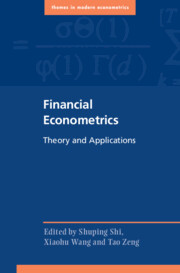Refine search
Actions for selected content:
2 results
5 - Infill Asymptotic Theory and Applications in Financial Econometrics
- from Part II - Continuous-Time Models and High-Frequency Financial Econometrics
-
- Book:
- Financial Econometrics
- Published online:
- 20 February 2025
- Print publication:
- 27 February 2025, pp 132-158
-
- Chapter
- Export citation

Financial Econometrics
- Theory and Applications
-
- Published online:
- 20 February 2025
- Print publication:
- 27 February 2025
